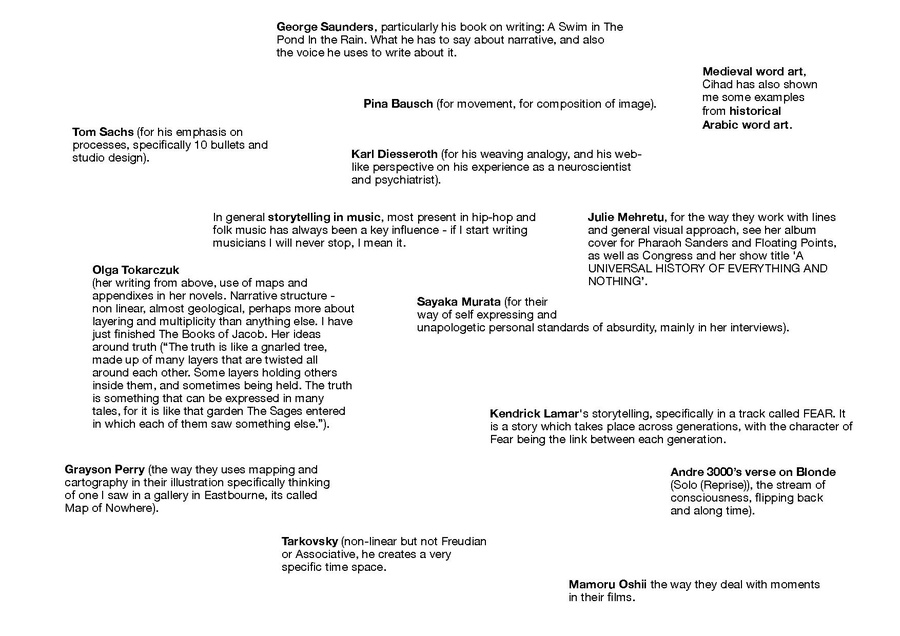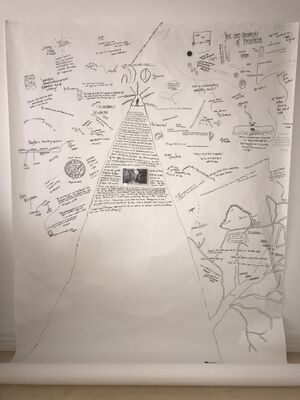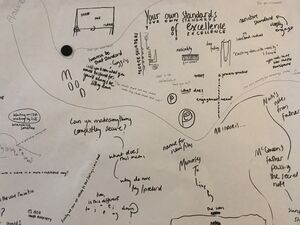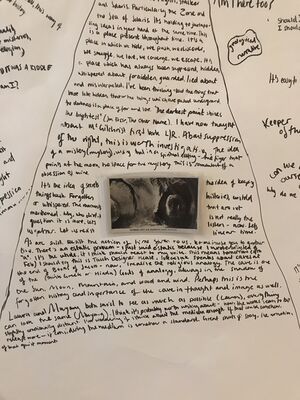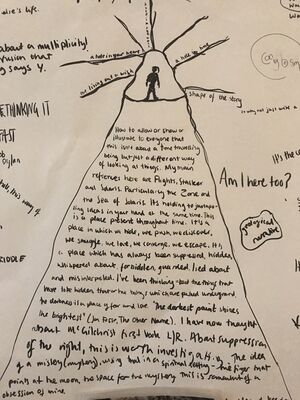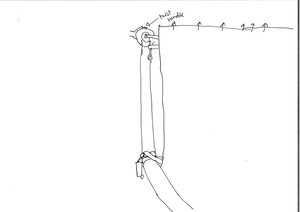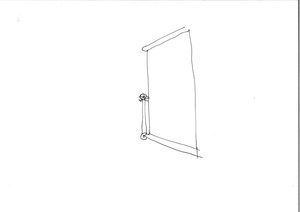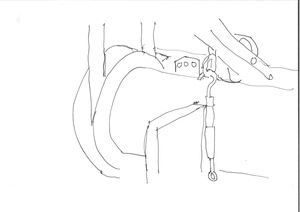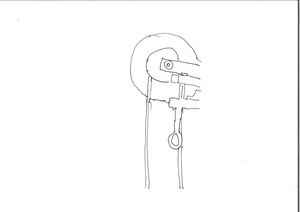Page Title: Text on (in) Practice
NOTE: I reference Tom Sachs here alot, this was written before the Curbed article which documented that his studio environment was very unhealthy.
Text On (in) Practice
This text is a result of a practice I call wall writing (although, I’d like to come up with a better name). In this practice, large rolls of paper (2 meters wide) are measured out to just above my head, and then stuck onto the wall in my living space. On these scrolls of paper I practice a number of things:
free writing, jotting down ideas on the go, drawing images from current work/future work, writing in shapes/word art, long form essayistic writing, fears/ worries, lyrics, recurring questions, cataloging feedback and drawing shapes of narratives etc.
All of these activities come together to form a kind of map on the wall.
Map making as a way of tracking the progression of thought, of eliciting connections, of moving whilst making, of making non-digital work, of forming images through word and discovering non-conventional narrative shapes. Fundamentally, this act stems from a desire-cum-frustration to reveal the circuitry/wiring between ideas I’ve seen. A process-practice with means to an end (a function in other words) but also a form of simple self expression in and of itself. The dual nature of this act is important. More on this later.
I am currently only writing in black ink on white paper. I use specific pens which have a soft felt tip, with an inky feel. I stand, squat or sit on the floor (being physically dynamic is important to my personal experience and it of course has an effect on the output). I have not cut the paper yet, but I do intend for there to be an end to this wall writing. Then I will begin another. I would like to create a rolling paper machine from hand (please see Appendix), inspired by the artist Van Neistat, he replied to an email I sent him and told me how to make it.
I am editing but showing the edits, making them visible (so far…). Whenever I begin chastising myself on the page (example? Or see Appendix?) I will edit (leaving the edit visible) to suggest a more open, accepting approach*. This is not just for kindness sake (although there is nothing wrong with kindness (kin-ness, Harraway)), but the chastising reveals other people's standards (gates and borders) I have ingested. Resisting those standards is very significant, as a definition of 'artist' I have come to adopt is a set of your own internal standards of excellence (Tom Sachs).
*Interestingly, my course mate Yalou, suggested that the polishing of a document perhaps feels linear (maybe a better word is final? A faux finality?).
So, what are ‘your own internal standards of excellence’? These are protocols to help me function as an artist, these are to be ‘fostered’ (Sachs) through the practice. What are the details you attend to? What is that, that moves you in an image? What is your aesthetic standard? What does engagement mean? And…these questions are not a definitive list, they are some seedlings, first stitches, lily pads to leap from (it’s about movement/flux).
A standard I have been exploring through the mapping (and more), is developing a specific approach to passage of time (sculpting of time) in my work. The struggle here has always been this: stories, and I mean ‘once upon a time there was a dog’ kind of stories, Chekov, Saunders, Bilge-Ceylan etc. You know the ones with the beautiful simple (simplicity, simplicity, simplicity - Einstein or maybe (really probably) his wife) structure. The ones that follow a character as they trudge or squeel or meander along a roman road of thought and action; have acted as a great bird, with great soft wings, to lay down upon and now (see!) life is quite beautiful. In other words they have been some of my most vital aids. And yet, there is a natural rebellion I hold against this synthetic/taxidermic relationship to the passage of time, it’s fundamentally retrospective. One brick does not have to lead to the next (remember when it was just sand? Remember it’ll become sand once again). There is also a political and philosophical resistance - ‘fuck linear time, it’s poison’ said the artist Tooth just last week. But, boy does it feel good to travel In The Cart* of Father Time.
*"In the Cart" (Russian: На подводе, romanized: Na podvode) is an 1897 short story by Anton Chekhov, also translated as "The Schoolmistress".
With this in mind, and slightly connected is another idea. I am trying to remove how central the finished work is to my practice, these works are destinations where I may arrive at, I circle, I return to but they are held by and do not exist without the roads that led me there, and the roads that do not. And this map making - it helps to stop thinking in a 'I need to make a thing' head space. More on this later.
I will write a list of my currently active influences:
I am pulled along by story and "beauty" and function*. Function, this is an important concept in my practice - a relatively new one. I have begun to understand and perhaps even respect the part of myself that likes to make and study systems, to be pulled into understanding how something functions - what the processes are, under the hood.
*One perspective on the wall writings, is perhaps I am attempting to make my thought behaviour function for me as an artist (Yalou and Aitana).
With all this said. I also deeply respect mystery (the hidden passage to the work) and to not look at the finger pointing to the moon, but the moon itself (Buddhist). It's a balance of creating processes and understanding how my practice functions whilst also remembering that not everything is understood or reduced down to functions, that there is always a slither of the infinite that surrounds a work which moves me. Yet, although you want to resist a binary, you have to bring a standard of logic to the practice. Working to code (Sachs).
It is important to note that my desire to create protocols and standards for myself as an artist came from a commitment to the profession of being an artist. This practice is something which is of course important to me on a personal level, 'the basement that allows the rest of my life to function' (Anne Berest) but also this is what I will do for my work and there is something very serious about this. I have to find a way to make it stable, something that I can come to every day. I need some kind of map then.
Influences Written as List
- Tom Sachs (for his emphasis on processes, specifically 10 bullets and studio design).
- Grayson Perry (the way he uses mapping and cartography in his illustration specifically thinking of one I saw in a gallery in Eastbourne, its called Map of Nowhere).
- Olga Tokarczuk (her writing from above, use of maps and appendixes in her novels. Narrative structure - non linear, almost geological, perhaps more about layering and multiplicity than anything else. I have just finished The Books of Jacob. Her ideas around truth (“The truth is like a gnarled tree, made up of many layers that are twisted all around each other. Some layers holding others inside them, and sometimes being held. The truth is something that can be expressed in many tales, for it is like that garden The Sages entered in which each of them saw something else.”).
- Pina Bausch (for movement, for composition of image).
- Sayaka Murata (for their way of self expressing and unapologetic personal standards of absurdity, mainly in her interviews).
- Iain Mcgilchrist (their insistence on mystery and their thoroughness/depth of thought).
- Karl Diesseroth (for his weaving analogy, and his web-like perspective on his experience as a neuroscientist and psychiatrist).
- Tarkovsky (non-linear but not Freudian or Associative, he creates a very specific time space *ref cinema cartography).
- Medieval word art, Cihad has also shown me some examples from historical Arabic word art.
- George Saunders, particularly his book on writing: A Swim in The Pond In the Rain. What he has to say about narrative, and also the voice he uses to write about it.
- Kendrick Lamar's storytelling, specifically in a track called FEAR. It is a story which takes place across generations, with the character of Fear being the link between each generation.
- Andre 3000’s verse on Blonde (Solo (Reprise)), the stream of consciousness, flipping back and along time).
- In general storytelling in music, most present in hip-hop and folk music has always been a key influence - if I start writing musicians I will never stop, I mean it.
- Mamoru Oshii the way they deal with moments in their films.
- Julie Mehretu, for the way they work with lines and general visual approach, see her album cover for Pharaoh Sanders and Floating Points, as well as Congress and her show title 'A UNIVERSAL HISTORY OF EVERYTHING AND NOTHING’.
Bibliogrpahy
Barthes, R. (2020) Camera lucida. London: Vintage Publishing.
Bausch, P. (2019) DEAD CAN DANCE. Available at: https://www.youtube.com/watch?v=EAdJ3XbUoK8.
Boyer, A. (2014) Questions for poets, Mute. Mute Publishing Limited. Available at: https://www.metamute.org/editorial/articles/questions-poets
Deisseroth, K. (2021) Projections: A story of human emotions. Manhattan: Random House Inc.
Ocean.F, Blake.J & André 3000 (2016) Solo (Reprise) [CD], Blonde. Austin, Texas: Jon Brion, Frank Ocean & MIKE DEAN.
Fosse, J. (2019) The Other Name: Septology I-II .Translated by Damion Searls. London: Fitzcaraldo.
Lamar.K (2017) FEAR. [MP3], DAMN. Sound City Studios, Los Angeles, California: Daniel Alan Maman.
Mamoru,O. Angel's Egg (1985) Angel's Eggs. Studio Deen.
McGilchrist, I. (2021) The matter with things. Our brains, our delusions, and the unmaking of the world. London: Talisker.
Mehretu, J. (2004) “Stadia II.”
Neistat, V. (2021) Why Comedians Are The Most Important Artists of Our Time.
Perlroth, N. (2023) This is how they tell me the world ends: The cyberweapons arms race. New York, NY: Bloomsbury Publishing.
Perry, G. (2008) “Map of Nowhere.”
Sachs, T. and Furgason, J. (2005) Ten bullets. N.Y.: Tom Sachs.
Saunders, G. (2022) A swim in a pond in the rain: In which Four Russians give a master class on writing, reading, and life. London: Bloomsbury.
Tokarczuk, O. (2021) Books of Jacob. Translated by Jenifer Croft. London: Fitzcaraldo.
Tarkosky, Stalker [DVD] (1979). Russia: Mosfilm.
Tzu, L. (1997) Tao Te Ching. Edited by A. Waley. Hertfordshire: Wordsworth Classics.

